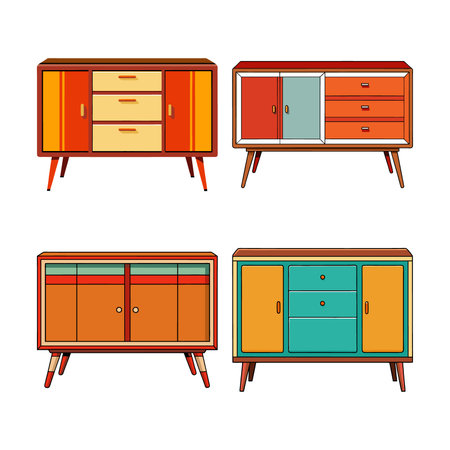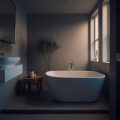Introduction to Home Office Design Evolution
In recent years, the way Americans approach home office design has undergone a significant transformation. Once an afterthought or a repurposed corner of the living room, home offices have now become essential spaces within the modern American household. This shift is largely driven by changes in work culture, with remote and hybrid work models becoming increasingly common. As a result, homeowners are investing more thought and resources into creating home offices that are not just functional, but also aesthetically pleasing and reflective of personal style. The influence of various design movements—especially Mid-Century Modern and Scandinavian styles—has played a pivotal role in shaping these new workspaces. These trends are redefining what it means to have a productive, comfortable, and visually inspiring environment at home, signaling a broader evolution in how Americans view both work and home life.
2. The Lasting Appeal of Mid-Century Modern Design
Mid-Century Modern design has left an indelible mark on American interiors, and its influence is especially evident in today’s home offices. Characterized by clean lines, organic shapes, and a focus on functionality, this style emerged in the mid-20th century and continues to resonate with homeowners who crave a blend of form and practicality. The enduring popularity of Mid-Century Modern in home office spaces can be attributed to its timeless aesthetic and adaptability to contemporary needs.
Defining Features of Mid-Century Modern Style
| Feature | Description |
|---|---|
| Simplicity | Minimal ornamentation, focusing on sleek, uncluttered forms that reduce visual noise. |
| Organic and Geometric Shapes | A harmonious mix of natural curves and bold geometric lines creates visual interest without excess. |
| Natural Materials | Frequent use of wood (especially teak, walnut, and oak), along with metal, glass, and leather accents. |
| Functionality | Every element is designed for purpose, making workspaces both beautiful and highly usable. |
| Pops of Color | Neutral bases are often accented with vibrant hues like mustard yellow, teal, or burnt orange for personality. |
The Enduring Popularity in American Home Offices
The resurgence of remote work has made the home office a focal point for design innovation. Mid-Century Modern’s emphasis on ergonomics and efficiency aligns perfectly with the demands of modern professionals. Iconic pieces such as the Eames desk chair or streamlined wooden desks not only enhance productivity but also elevate the overall ambiance of the workspace. Additionally, the versatility of Mid-Century furniture allows it to blend seamlessly with other styles—be it Scandinavian minimalism or industrial chic—making it a favorite among Americans seeking both nostalgia and modern comfort in their home offices. Ultimately, this timeless style offers a balance between aesthetics and functionality that keeps it relevant across generations.
![]()
3. Scandinavian Design: Creating Calm and Functionality
Scandinavian design has experienced a significant surge in popularity across American home offices, driven by its signature blend of simplicity, practicality, and a focus on well-being. Rooted in the principles of minimalism, this style emphasizes clean lines, uncluttered spaces, and a soothing color palette—think whites, soft grays, and natural wood tones. The goal is to create an environment that feels open and serene, helping to reduce stress and increase productivity while working from home.
Functionality sits at the heart of Scandinavian design. Home office furniture often features streamlined shapes with multipurpose uses, allowing for seamless storage solutions that keep workspaces organized and efficient. Desks with built-in drawers or wall-mounted shelves exemplify how this style maximizes utility without sacrificing aesthetic appeal. Ergonomic seating and adjustable lighting are also key components, supporting physical comfort during long hours at the desk.
Perhaps most notably, Scandinavian design brings a sense of wellness into the home office. By incorporating natural elements such as houseplants or ample daylight through large windows, the workspace becomes more inviting and refreshing. This connection to nature—often referred to as “hygge” in Nordic culture—encourages a balanced approach to work, inspiring creativity and promoting mental clarity. For many Americans adapting to remote work, these Scandinavian influences offer a welcome antidote to the chaos of daily life, transforming home offices into calming retreats designed for both efficiency and peace of mind.
4. Blending Styles: Eclectic and Personalized Home Offices
One of the most distinctive aspects of American home office design is the tendency to blend multiple design trends, resulting in uniquely eclectic and deeply personalized spaces. Rather than sticking rigidly to a single aesthetic, many Americans create workspaces that borrow elements from Mid-Century Modern, Scandinavian, Art Deco, Industrial, Boho, and other styles to reflect their personalities, values, and functional needs.
The American Spirit of Mixing and Matching
This approach reflects the broader American ethos of individualism and creativity. For instance, someone might pair a sleek Eames chair (Mid-Century Modern) with an exposed brick wall (Industrial), add a velvet Art Deco lamp for glamour, and top it off with a Bohemian-inspired woven rug. The result is a home office that feels both curated and lived-in, where every piece tells part of the occupant’s story.
Popular Elements from Different Styles
| Design Style | Common Features in Home Offices |
|---|---|
| Mid-Century Modern | Clean lines, tapered legs, minimalist desks |
| Scandinavian | Light woods, neutral palettes, functional storage |
| Art Deco | Bold patterns, metallic accents, geometric shapes |
| Industrial | Exposed metal, reclaimed wood, utilitarian lighting |
| Boho | Layered textiles, plants, global decor pieces |
Personalization through Eclectic Design
This blending of styles isn’t just about aesthetics—it’s about functionality too. Americans often choose pieces that cater to their workflow and comfort, such as ergonomic Industrial-style chairs or Scandinavian-inspired shelving units for organization. By mixing eras and influences, these home offices become more than just places to work; they are expressions of identity and inspiration zones that help foster productivity and well-being.
5. Functionality Meets Aesthetics: Practical Tips and Examples
Blending style and productivity is at the heart of effective home office design, especially when drawing inspiration from Mid-Century Modern, Scandinavian, and other influential aesthetics. Here’s how you can create a workspace that looks great and works even better.
Choose Furniture That Works as Hard as You Do
Mid-Century Modern desks with clean lines and tapered legs not only bring a retro vibe but also offer ample space without feeling bulky. Pair these with ergonomic Scandinavian-style chairs that prioritize comfort for long work hours. For example, a walnut veneer desk combined with an adjustable mesh chair brings together classic charm and modern support—perfect for Zoom calls or creative brainstorming sessions.
Let Lighting Set the Mood and Boost Productivity
Good lighting is essential for any home office. Scandinavian design is famous for maximizing natural light, so position your desk near a window if possible. If not, opt for adjustable LED lamps in neutral tones—these echo Nordic minimalism while reducing eye strain during late-night projects. One popular choice among remote workers in the U.S. is a matte brass task lamp that adds a Mid-Century accent while providing focused illumination.
Decor That Inspires Without Distracting
Avoid clutter by selecting décor that serves a purpose. Minimalist shelves keep supplies organized yet accessible, while a few well-chosen art prints or indoor plants add color and personality without overwhelming the space. Try using geometric-patterned rugs reminiscent of Mid-Century style or textured throws in soft, Scandinavian hues to create warmth and visual interest.
Real-Life Example: The Cozy Corner Office
Take inspiration from Emily in Portland, Oregon, who transformed her guest room into a productive nook using a vintage teak writing desk (a nod to Mid-Century Modern), paired with white floating shelves for books and storage bins—a touch of Scandi functionality. She added a leafy pothos plant and a framed inspirational quote above her monitor to keep things cheerful and motivating.
Quick Tips for Balancing Beauty and Productivity
– Stick to a neutral palette with pops of color for energy.
– Invest in multi-functional furniture, like storage ottomans or modular shelving.
– Prioritize ergonomic accessories such as wrist supports or footrests.
– Layer textures for coziness—think wool throws or felt organizers.
– Personalize thoughtfully; display items that make you smile but don’t distract from your workflow.
By combining timeless design elements with practical choices, you can craft a home office that feels both inviting and efficient—a true reflection of American creativity inspired by global design traditions.
6. Looking Forward: The Future of Home Office Design in the US
As remote and hybrid work become more deeply embedded in American culture, the future of home office design will continue to evolve, drawing inspiration from mid-century modern, Scandinavian, and a diverse range of global styles. Emerging trends point toward even greater personalization, with spaces curated not only for productivity but also for mental well-being and creative expression. Expect to see increased use of sustainable materials, biophilic elements like indoor plants and natural light, and smart technology seamlessly integrated into everyday workspaces.
American home offices are likely to reflect the country’s emphasis on individuality and flexibility. Modular furniture—allowing quick transformation from work mode to relaxation or family time—will become standard. There will be a growing focus on wellness: ergonomic seating, standing desks, and calming color palettes inspired by Scandinavian minimalism or mid-century hues will help foster both comfort and inspiration.
As diverse communities shape the cultural landscape, home office aesthetics may further embrace eclectic influences—melding vintage finds with contemporary pieces, blending bold colors with minimalist designs, and incorporating local art or crafts. The blending of work and life at home will push designers to create zones that balance privacy with openness, supporting concentration while celebrating personal style.
In the coming years, technology will play an even bigger role, with voice-activated lighting, climate control, and virtual reality tools for collaboration becoming commonplace. American values such as innovation, inclusivity, and adaptability will continue to drive these changes. Ultimately, the future of home office design in the US is set to be dynamic—a blend of timeless design principles and forward-thinking solutions that reflect both changing work habits and the unique spirit of American homes.

